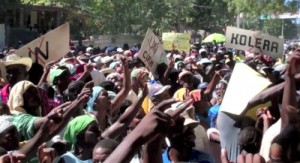
December 9, 2011: Angered by the UN-caused cholera epidemic that has claimed thousands, Haitians rallied at the UN Stabilization Mission in Haiti (MINUSTAH) Base at St. Marc. Photo: from a video produced by Nick Stratton, Bureau des Avocats Internationaux. Watch it at http://ijdh.org/archives/24340.
Two years after an earthquake killed 158,000, the majority of Haitians continue to battle against hunger, disease, homelessness and political repression. Half a million people remain in refugee camps and many thousands who have found other accommodations are living in buildings that have been designated as unsafe and requiring demolition or major repairs.
Clean water is unavailable to almost half the population and sanitation, in the form or latrines, is available to only 34%. It is a formula for disease, and the 2010 cholera outbreak, traced to the criminally negligent sewage disposal practices of UN troops, sickened nearly 500,000 people and killed more than 6,500 others.
With all of the aid money that has been pouring into Haiti, it would not be unreasonable to expect living conditions to be much better than they are. Journalist Kim Ives, a writer and editor of Haiti Liberté, who spoke on this topic last Thursday at the University of Manitoba, provided this summary:
- $2.4 billion in bilateral relief aid (emergency aid) delivered to date
- $4.5 billion was pledged for bilateral recovery in 2010, 2011 (plus $1 billion for debt relief). As of Dec, 2011, $2.4 billion of that was delivered.
- Donors have dispersed an additional $560 million in recovery assistance.
- An additional $3.1 billion for relief and recovery from NGOs and other private donors. (The largest share of that came from the Red Cross, which raised $1.4 billion; of that, only 50% has been spent. I wonder where the rest went?)
- Cholera treatment funding of $172 million has been promised; $130 million has been disbursed.
Clearly something is wrong. Kim Ives summarized the obstacles to effective aid and reconstruction as follows:
- A weak and under-funded national government, as a result of two centuries of foreign intervention and plunder
- A large presence of international aid organizations and UN agencies, accountable, first and foremost, to their donors and home governments
- A right-wing presidency brought to power through an exclusionary and fraudulent electoral process
- A foreign police and military force (MINUSTAH) dating from the 2004 coup d’etat and whose purpose is to preserve the status quo
If you want to know more, watch my video report.
Resources
Canada Haiti Action Network
Winnipeg Haiti Solidarity Group
Institute for Justice and Democracy in Haiti
Haiti Liberté

